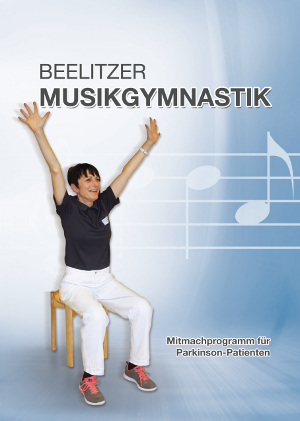
30-12-2014. In the sports hall of the Neurological specialist hospital for movement disorders / Parkinson's in Beelitz-Heilstätten 12 patients sit in a chair. Suddenly you hear the command "Stretch your arms - bend, stretch - bend!" Slowly everyone moves their arms behind their backs and forwards again in one big sweeping movement. A cheerful music plays along with it. It sounds upbeat, like disco music, but you can recognize the song Muss i denn zum Städtele hinaus (German folk song). Some sing to move. Movements and music merge, almost like ballet. The tempo becomes faster, the music becomes rhythmic and louder. Soon the participants move much faster than at the beginning. Everyone is now trying hard to keep up the pace. Suddenly the end is over and the voice calls again: "Shake out and shake!" A rhythmic, rippling "shaking music" accompanies the loosening of the arms. You can hear a heavy breath.
When treating the Parkinson's disease From the beginning, activating therapies play a major role in maintaining physical performance. Many applications can be carried out effectively in self-training. Those affected go cycling, swimming, jogging, do Nordic walking or take a dance class. In general, it is important to exercise physically as daily as possible. This alleviates the symptoms and can slow the course of the disease.
A program for home-based training has now been developed in the Parkinson's specialist clinic in Beelitz-Heilstätten. In the collaboration of physiotherapists and music therapists, a unique movement training with functional training music was created: Beelitz music gymnastics. The special thing about it is a special music. Melody, rhythm, harmony - everything has been designed so that every movement can be heard exactly.
The suggestion for this comes from the concept of Neurological Music Therapy - a standardized scientific methodology from the USA. The music sets the pace and precisely marks the use of force in the movement.
It has long been known what an important role music plays for many people with Parkinson's. Even listening to loud and rhythmic music leads to a measurable improvement in mobility. Dopamine is released in the brain. The mobility improves - only by hearing! Many Parkinson's patients know this from their own experience.
These effects are used for therapeutic applications such as dance therapy or music-assisted gait training. The special thing about Beelitz music gymnastics: it can be performed independently at home and while sitting. All you need is a CD player. The exercises are designed in such a way that all important parts of the body are included - the feet, the legs, the torso, the arms.
In order to be able to use the program independently at home, there is an illustrated booklet in which all exercises are explained in detail. In this way, those affected can remain active and mobile in the home. The music conveys a long-missed feeling: joy in movement.